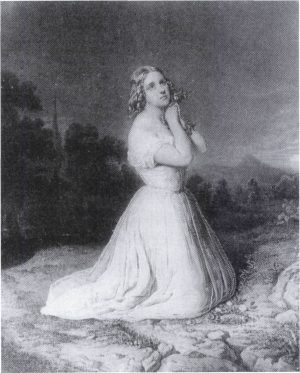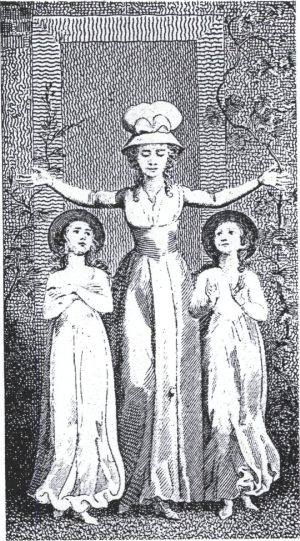
As an example of woman’s true nature – that is, vanity – Rousseau, in the novel Émile from 1762, refers to a little girl who, when forced to learn to write, refuses to produce anything other than hundreds of variants of the letter ‘o’. One day during her learned exertions she catches sight of herself in the mirror. Oh horror! What an un-feminine posture! In disgust she hurls away the goose feather pen. But Rousseau should have known that he was talking through his hat. Like other male belletrists he had been schooled by the female successors of les précieuses. These were learned ladies who, from their well-visited salons, directed the debates over issues of both cultural and current interest with soft and steady hands. With the French Revolution, politics moved out into the street and became men’s business. To be on the safe side, Napoleon had male supremacy put into law. The French women had to tone down.
However, they did not immediately put down the quill. In 1807 a sparkling depiction of the female genius spreads like wildfire through occupied Europe. In Germaine de Staël’s successful novel Corinne ou l’Italie, the young poetess Corinne is crowned at the Capitol. All of Italy and many a handsome lord lie at her feet.
Germaine de Staël became the standard-bearer of a whole generation of female authors in Europe. This world-famous woman was a Swedish subject on account of her marriage to the Swedish ambassador in Paris. In 1812-13, during the long period she was fleeing from Napoleon, she visited Stockholm, and in Sophie von Knorring’s novel Illusionerna (The Illusions, 1836) she is described as a little, stocky, but magical lady. Germaine de Staël held court wherever she and her entourage – of friends, lovers, and children – turned up. To many, she incarnated civilisation in a time of barbarism. Germaine de Staël was one of Napoleon’s most powerful opponents. Thanks to her, a picture was propagated of Woman as a looming threat or a promise of change. This was the case in Sweden as well. Malla Silfverstolpe (1782-1861), the hostess of the most influential salon during the Swedish Romantic period, would read Germaine de Staël, but if she dreamed of being honoured like Corinne, she was in for a disappointment. In Swedish literary history she is remembered as a “genius at friendship”. Yet, in her memoirs Malla Silfverstolpe oversteps the bounds of propriety by coldly exploiting the Romantic notion that woman’s true genius lies in her heart.
Perhaps the very core of female Romanticism lies in the question of whether love and pain are necessarily inseparable. The female authors endeavour to redefine the Romantic, complementary gender ideology, according to which the woman must be an emotional vestal virgin in relation to the man, who possesses true creative power. The words of the Swedish national bard, Esaias Tegnér, in a letter from 1837, are typical: “In general, the woman carries a sounding board in her breast and is full of the poetry of nature; and this is what attracts me to her.”
Martina von Schwerin, one of the many gifted women from the Romantic period – mainly known for her correspondence with Esaias Tegnér – changed Descartes’s rationalist dictum “I think, therefore I am” into “I feel – therefore I am happy”.
Swedish Romanticism is described – at least in the hindsight of literary historiography – as a very male domain. Despite the fact that the period saw considerable generational oppositions, in literary history a picture has been drawn of the victorious party as being the very first of the lyrical boys’ gangs that have ever since then occupied the positions of eminence on the Swedish Parnassus, namely ‘fosforisterna’ (the Phosphorists), headed by the teenager Per Daniel Amadeus Atterbom.
The poetic revolution advocated by men was based on a number of societies – Auroraförbundet (The Aurora Society), Iduna (Iduna), Götiska förbundet (The Gothic Society) – all of which more or less excluded women and exalted male virtues. As with the journal Phosphoros (1810), which is usually considered the starting point of Romanticism in Sweden, their model was German Romanticism with its unfavourable disposition towards the French, ‘feminine’, influence.
In the light of this usual definition of ‘Romanticism’ in literary history, there are barely any female writers to be found in Sweden between Anna Maria Lenngren and Fredrika Bremer. The heyday of male Romanticism had already passed when, in the 1830s and 1840s, women began to publish their works more frequently. The market clearly was not propitious for female Romantic writers in Sweden. However, it can also be argued that Romanticism continued to exercise its influence, especially as regards the women, far into the period we call Realism.
In their bibliography, Kvinnan inom den svenska litteraturen (1893; The Woman in Swedish Literature), Sigrid Leijonhufvud and Sigrid Brithelli nevertheless list a number of women from the Romantic period who published poetry, songs, novels, short stories, and translations. An example is Eleonora Charlotta d’Albedyhll’s (1770-1835) Old Norse heroic poem Gefion (1814; Gefion). Gefion is said to have founded the Scandinavian countries and is also said to have taught the Nordic people how to extract and use the riches of the soil and the mountains, to peaceful ends. Christina Charlotta Berger’s (1784-1852) novel Albert och Louise eller Den dubbla upptäckten (1817; Albert and Louise, or the Double Disclosure) is a story about love with obstacles and includes many sentimental and Gothic horror elements. In “Om jag får be om ölost”: Kring kvinnliga författares kvinnobilder i svensk romantik (1991; “Could I Have the Cheese”: On Female Writers’ Descriptions of Women in Swedish Romantic Literature), Eva Borgström tells us that Dorothea Dunckel (1799-1878) collected a number of writings in various genres in Dramatiska och lyriska forsök 1-3 (1828-32; Dramatic and Lyrical Essays).
The Heroine of Exile
Mary Wollstonecraft (1759-97), the author of A Vindication of the Rights of Woman (1792), was a type of woman that is not very common in Sweden in the Romantic period. Abandoned in England by her lover and the father of her child, she resolutely brought her young ‘natural’ daughter with her on a strenuous business travel to Scandinavia. Her loss of love is painful but her identity as a ‘free’ woman appears to be more important to her.

Wollstonecraft was radical in every sense of the word and had eagerly reported on the initial phase of the French Revolution. As she is now, in 1795, travelling around Scandinavia, she grasps the opportunity “to note the present state of morals and manners” in this exotic northern corner of Europe. In her view, this is most clearly manifested in the way women and men associate with each other. Her observations of the, to a greater or lesser extent, oppressed Scandinavian women are both subjective and random, but as documentation they are nevertheless valuable.
In Sweden, she appears to have mainly encountered representatives of the lower social classes, and that leads her to wonder about the hard circumstances of the unskilled women labourers. Morally the country is bankrupt, if we are to trust the cultivated English observer. On one occasion, she comes upon a group of intoxicated people, who had attended the local fair, and is amazed at the crudity of both sexes. Here people drink and smoke and copulate to their heart’s desire:
“I do not now wonder that the girls lose their fine complexions at such an early age, or that love here is merely an appetite to fulfil the main design of nature, never enlivened by either affection or sentiment.”
Mary Wollstonecraft on the Swedes:
“Still the men stand up for the dignity of man by oppressing the women. The most menial, and even laborious offices, are therefore left to these poor drudges. Much of this I have seen. In the winter, I am told, they take the linen down to the river, to wash it in the cold water, and though their hands, cut by the ice, are cracked and bleeding, the men, their fellow-servants, will not disgrace their manhood by carrying a tub to lighten their burden.”
In Norway, she moves in the upper classes and is delighted with the culture that is to be found there – that is, found there only among the women! The reader gets the impression of entering into a novel by Camilla Collett.
“At Christiania [i.e., modern Oslo] I met with that polite reception, which rather characterises the progress of manners in the world, than of any particular portion of it. The first evening of my arrival I supped with some of the most fashionable people of the place; and almost imagined myself in a circle of English ladies, so much did they resemble them in manners, dress, and even in beauty […].”
In Denmark, Mary Wollstonecraft gets herself worked up about the national self-righteousness that forces the middle-class women into the role of “notable housewives; without accomplishments, or any of the charms that adorn more advanced social life”. Meanwhile, the middle-class men degrade the institution of marriage by having “promiscuous amours […] with their female servants”. Interestingly enough, Mary Wollstonecraft makes observations about the period of ‘conditioned freedom’ so cherished by our female authors, namely the period just before the women enter into marriage.
Denmark impresses Wollstonecraft the least: “I have before mentioned that the men are domestic tyrants, considering them as fathers, brothers, or husbands; but there is a kind of interregnum between the reign of the father and husband, which is the only period of freedom and pleasure that the women enjoy. Young people, who are attached to each other, with the consent of their friends, exchange rings, and are permitted to enjoy a degree of liberty together, which I have never noticed in any other country.”
Letters Written During a Short Residence in Sweden, Norway, and Denmark was first published in 1796 and became a great success in England and America. The book was translated into many languages, among them, and as early as in 1798, into Swedish (under the title Bref skrifna under et kort vistande i Sverige, Norrige och Danmark).
Whereas Mary Wollstonecraft was a radical Romanticist in her writing as well as in her life, the Nordic female authors found it more difficult to rise above the prejudices of what was suitable for women. In Sweden at least, a patriarchal religiosity sanctioned a widespread oppression of women at all levels. To this must be added the male-chauvinist profile of the Romantic writers. The passive female ideal, propagated by Rousseau and dominant on the continent, was what the female English, French, and German authors tried to escape from by going into exile, both metaphorically and literally. In Scandinavia this way out was seldom used. The great Swedish exception is Fredrika Bremer who, in the later part of her life, reported from her extensive travels around the world.
Translated by Pernille Harsting

